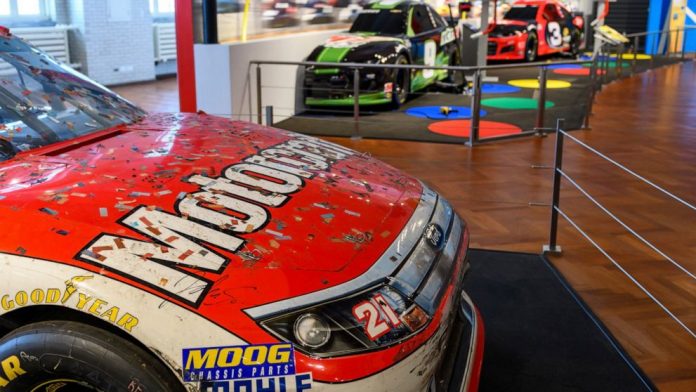DEARBORN, Michigan – The first stop on Romain Grosjean’s month-long tour of the United States with his family was the Henry Ford Museum of American Innovation, where his wife arranged a tour for the racer and their three children.
On the day The Associated Press visited, IndyCar rookie Scott McLaughlin happened to be in the parking lot waiting for the doors to open.
No wonder motorists are so interested: the National Monument Museum, founded in 1929 by the creator of the Model T and father of the Ford Motor Co., houses some of the most historic objects in US history, including the presidential sedan of John F. Kennedy, the Chair used by Abraham Lincoln in Ford’s Theater, the Rosa Parks bus, and the Wright Brothers bike shop.
The newest wing of the museum includes an extensive, interactive exhibition “Driven to Win”, which offers a comprehensive insight into motorsport in all its forms. It took more than a decade from conception to the doors opening earlier this year as part of a rare collaboration between rivals Ford and General Motors, the show’s presenting sponsor.
“Racing is the embodiment of American innovation in the world of sport, but its reach extends well beyond the racetrack to our showrooms, our streets and our culture,” said Mark Reuss, president of General Motors, to The Associated Press the exhibition.
“‘Driven To Win’ documents and celebrates these contributions with an exciting and comprehensive presentation of the past, present and future of motorsport,” he told Museum. “
The permanent exhibition takes visitors to a chronicle of motorsport, from soapbox derbies to indy cars, stock cars and dragsters. The Sports Car Performance Center is showing a faithful clay model of a Ford GT. It’s in the same area as the winning car that Ford used when the automaker returned to Le Mans in 2016 – a celebration of the 50th anniversary of Ford’s 1-2-3 finish in the 1966 endurance race.
One of the vehicles on display at the entrance to the 24,000 square meter exhibition is “Sweepstakes”, the 1901 racing car that Henry Ford used after the collapse of his first car company, Detroit Automobile Co. Amid doubts about his engineering and businessman skills, Ford believed that a successful racing car would restore its credibility. On October 10, 1901, the racing novice Ford drove the competition to a victory over the more established Alexander Winton at a racecourse in Grosse Pointe, Michigan.
“I was impressed that the exhibition takes you through the motorsport timeline from the contest to today,” said Mark Rushbrook, global director of Ford Performance, to AP. “It takes you through all the different racing series and disciplines and the connections between people and technology and how that was carried over to road cars.”
This is done through interactive displays with simulators, a pit stop challenge and a hand-eye coordination test to measure motor skills and the ability to make decisions in a split second. A 15-minute short film is shown in a multi-sensory theater and shows five racing drivers pursuing their dreams.
The film follows two-time IndyCar champion Josef Newgarden (a Chevy driver) as he prepares for the Indianapolis 500; Brehanna Daniels, NASCAR’s first black female tire fitter; cross-generational Bonneville Salt Flats racer Megan Volk; Drag racer Brittany Force; and Tim Hardy, a Pikes Peak International Hill Climb Racer.
Trevor Bayne’s winning Daytona 500 car from 2011 is on display, as is the “Yellow Submarine” Chevy-Penske Indy car that Rick Mears drove to his third Indianapolis 500 victory in 1988. One of the AJ Foyt memorabilia is the 1960 Meskowski-Offenhauser Indy Roadster, which helped Foyt to his first three Indy car championships in 1960, 1961 and 1963.
“When I saw the exhibition for the first time, it completely exceeded my expectations,” Edsel Ford II told AP. Edsel Ford is a board member of Henry Ford, longtime general manager of the company founded by his great-grandfather and a NASCAR Hall of Fame member for his contributions to motorsport.
“The exhibits are sensational and a lot of us had seen the drawings and had numerous discussions about what it would look like, but finally seeing it physically just took my breath away,” said Ford. “I find it so … overwhelming. “
McLaughlin, a New Zealander and three-time V8 supercar winner who is now driving for Roger Penske in his first IndyCar season, has filmed a social media series titled “Scott Learns America” in which he made iconic stops along the racetrack visited. The Henry Ford was the Chevrolet driver’s stop during IndyCar’s double race in Detroit earlier this season.
McLaughlin enjoyed the exhibit even though the interactive reaction time test was a letdown – “I was awful, I was pretty shameful in the lower half of the day, 64%,” he said. But the pieces of American history throughout the museum have left an indelible mark.
He spent part of his visit in the aviation section of the museum, which housed a replica of the 1903 Wright Flyer, which Wilbur Wright used for the first heavier-than-air machine-powered flight.
Wright’s journey lasted 12 seconds and covered 120 feet.
“I liked the Wright Brothers stuff and seeing how far they actually went, and I think that matters to me because we always talk about downforce without trying to fully learn uplift,” said McLaughlin. “They didn’t even know what downforce was, or they knew what it was and didn’t have a name for it, so it was cool that the Wright Brothers made uplift for us.
“The whole museum just shows how incredible America’s history is and how much innovation the whole world has brought forward.”
——
More AP car races: https://apnews.com/hub/auto-racing and https://twitter.com/AP—Sports

